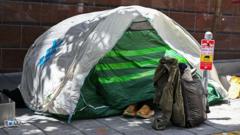In recent weeks, Washington DC has witnessed a crackdown on homeless encampments as federal agents clear the streets in a strategy reminiscent of actions taken in San Francisco. This shift comes after President Trump, who has often criticized the Golden State for its homelessness crisis, began to mimic its policy frameworks. Initiated last summer, the decision to penalize individuals for sleeping on the streets followed a pivotal US Supreme Court ruling affirming the legality of such actions in the absence of sufficient shelter.
This trend of criminalizing homelessness sparked a nationwide wave of punitive measures, with urban areas across America issuing citations and penalties to rough sleepers. In California, Governor Gavin Newsom made homelessness a priority, particularly after serving as mayor of San Francisco, which has made significant strides in diminishing visible homelessness, yet has faced harsh critiques in some quarters.
The issue of homelessness has intensified since the pandemic, where factors such as mental health struggles, addiction, and a staggering shortage of affordable housing have exacerbated the crisis. The disparity between the wealth in tech-driven regions and the appearances of dire poverty has led to backlash among residents. An app launched in 2018, "SnapCrap," drew attention to the trash crisis in the city, capturing the essence of frustration felt by locals. The rise in tent encampments during the pandemic, reported to have surged from 419 to over 1100, highlighted the urgency for solutions.
Responding to this struggle, initiatives aimed at providing shelter opportunities surged in momentum. While some serviced rapid housing placements, others faced community resistance, as the idea of supportive housing pitched against local concerns lingered. Particularly after a pivotal Supreme Court decision in 2024, San Francisco's then-mayor London Breed declared a necessity for aggressive removal of tent encampments, leading to a notable spike in citations for illegal lodging.
Despite the actions taken to clear encampments, advocates argue that punitive measures ultimately fail to address the root causes of homelessness. Critics claim that simply cycling homeless individuals in and out of neighborhoods does not foster real solutions to the challenges faced.
Although subsequent mayors, including London Breed's successor Daniel Lurie, maintained these policies leading to a decrease in visible tent encampments—as evidenced by a biannual count showing tents reduced from 319 to merely 165—data indicates that overall homelessness numbers have risen, suggesting that while tents might be removed, underlying issues persist.
The costs to combat homelessness in San Francisco have been steep, with the city investing $846 million earmarked for fiscal year 2024-2025 to alleviate the crisis. City officials are also taking steps to increase shelter capacity and extend stays for families, acknowledging the multifaceted nature of homelessness, which intertwines with crises of mental health and substance abuse.
As cities like San Francisco and Washington DC continue to implement stringent policies, experts caution against framing these strategies as effective solutions. Removing encampments without addressing the underlying needs of homeless individuals can lead to further destabilization. Critics stress the absence of a quick fix for complex socio-economic challenges that countless vulnerable individuals face in their journey toward stability and dignity.
This trend of criminalizing homelessness sparked a nationwide wave of punitive measures, with urban areas across America issuing citations and penalties to rough sleepers. In California, Governor Gavin Newsom made homelessness a priority, particularly after serving as mayor of San Francisco, which has made significant strides in diminishing visible homelessness, yet has faced harsh critiques in some quarters.
The issue of homelessness has intensified since the pandemic, where factors such as mental health struggles, addiction, and a staggering shortage of affordable housing have exacerbated the crisis. The disparity between the wealth in tech-driven regions and the appearances of dire poverty has led to backlash among residents. An app launched in 2018, "SnapCrap," drew attention to the trash crisis in the city, capturing the essence of frustration felt by locals. The rise in tent encampments during the pandemic, reported to have surged from 419 to over 1100, highlighted the urgency for solutions.
Responding to this struggle, initiatives aimed at providing shelter opportunities surged in momentum. While some serviced rapid housing placements, others faced community resistance, as the idea of supportive housing pitched against local concerns lingered. Particularly after a pivotal Supreme Court decision in 2024, San Francisco's then-mayor London Breed declared a necessity for aggressive removal of tent encampments, leading to a notable spike in citations for illegal lodging.
Despite the actions taken to clear encampments, advocates argue that punitive measures ultimately fail to address the root causes of homelessness. Critics claim that simply cycling homeless individuals in and out of neighborhoods does not foster real solutions to the challenges faced.
Although subsequent mayors, including London Breed's successor Daniel Lurie, maintained these policies leading to a decrease in visible tent encampments—as evidenced by a biannual count showing tents reduced from 319 to merely 165—data indicates that overall homelessness numbers have risen, suggesting that while tents might be removed, underlying issues persist.
The costs to combat homelessness in San Francisco have been steep, with the city investing $846 million earmarked for fiscal year 2024-2025 to alleviate the crisis. City officials are also taking steps to increase shelter capacity and extend stays for families, acknowledging the multifaceted nature of homelessness, which intertwines with crises of mental health and substance abuse.
As cities like San Francisco and Washington DC continue to implement stringent policies, experts caution against framing these strategies as effective solutions. Removing encampments without addressing the underlying needs of homeless individuals can lead to further destabilization. Critics stress the absence of a quick fix for complex socio-economic challenges that countless vulnerable individuals face in their journey toward stability and dignity.



















